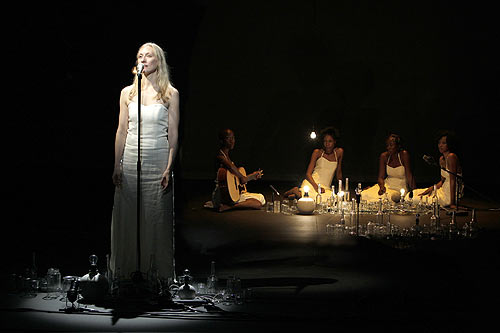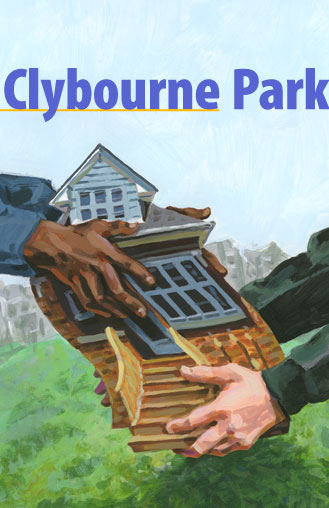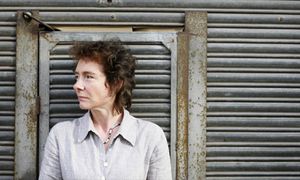I’d like to take a moment to talk about a work of contemporary art that holds a special place inside my heart. It is frightening, awe-inspiring, chillingly beautiful, and has more depth than most movies, books, or plays that I’ve read over the last several years. It has influenced my views on the boundaries of theatrical performance, and convinced me for good that digital mediums can, in fact, constitute a form of art.
The creation that I speak of comes not from the likes of Miller, Picasso, or Scorsese. It was developed over several years, beginning in 2004, by 2K – a company based right here in Boston, Massachusetts. It’s title? BioShock.
That’s right. Although it may be hard to believe, and to some, seem entirely impossible, a video game has a place among my greatest artistic influences. BioShock is the perfect illustration of the potential which games have as mediums of creative and narrative expression. It has the distinction of being one of the few game titles which is not merely inspired by a philosophy, but constitutes a philosophical statement in and of itself. This epic twelve-hour adventure goes above and beyond its contemporaries, crafting a living, breathing world around the player – a tragic realm that only grows more visceral as one explores deeper into its darkest, dankest recesses.
On the surface, BioShock’s narrative reads like a typical “man-alone” adventure story. The player assumes the role of Jack, a mild-mannered, non-descript man travelling across the Atlantic Ocean on a jet liner, circa 1960. As the plane journeys high above the blue-green void, it suddenly takes an inexplicable nose-dive into the water, snapping in two and flinging Jack into the icy darkness below. As Jack struggles to the surface, surrounded by flaming wreckage and soggy remnants of luggage, his eyes are drawn to a beacon of light hovering over the water a hundred yards distant. Desperate, he swims through the frigid waves and discovers a lighthouse, jutting inexplicably out of the ocean in defiance of all rationality. Jack climbs the structure and, with no other options apparent, opens the door to the house.
And this is where the real story begins. For what Jack has uncovered is – quite literally – the mere tip of the iceberg, the sole entrance to the elaborate underwater city of Rapture. Concealed inside the lighthouse is an ancient bathysphere, waiting ominously for a passenger to order it downward into the crushing depths. As Jack, the player is left with no other option except to climb in and pull the lever, not knowing what they are accomplishing or why.
(I would like to delve into further detail about the story and setting of the game, but I don’t think my words could adequately do it justice – considering the full experience is subjective and quite lengthy to begin with. This short video should suffice, however.)
There is something to be said about the unique experience one has when playing a video game, as opposed to any other form of entertainment. Games do not rely on the passivity of their audience, but – much like the turning of the pages of a book – requires their players to actively pursue the resolution to the story, or to accomplish a tangible goal. Here is where the greatest wealth of possibility in gaming-as-an-art-form lies, and the one thing that many developers have been forgetting over the last several years. Games are not movies. They are not plays, and they are not books. If a video game is described as a “cinematic” experience, great. Now I know what game to avoid purchasing. Games are, at their core, an interactive experience, and the most successful titles are the ones which allow players to enter into a conversation with the world of the game itself.
Here is where BioShock really shines. It doesn’t need to urge the player forward with a commanding officer barking orders into a radio (although one is given to the player as a means of communication), or with a linear environmental design consisting of corridor after nondescript corridor. When one steps out of the bathysphere and into the unfamiliar territory of Rapture, the player is compelled to explore from within. Of course, the game does provide a subtle nagging presence from the get-go in the form of the Splicers, mutated ex-humans who stalk the player from the shadows throughout the game. But the sense of urgency is provided by the environment, and not fed artificially to the player. Hell, everything about the game’s story is provided through environmental context: through audio logs, diaries, graffiti, posters, and an ever-present PA blaring “helpful” propaganda messages to the citizens of Rapture. It is entirely possible for several people to play through BioShock from start to finish and have each individual recall a different version of not only the story, but which characters were good, evil, or somewhere in between. The only thing limiting a player’s immersion into the role which BioShock hands them is their curiosity and willingness to explore.
And exploration – also unlike many similar games – is a reward in and of itself. Rapture is stunning, even four years after being released (which in video game years is practically two decades). Rapture is a psychedelic blend of art deco and late-1940s New York City in its public areas and facades, with a sharply contrasting steampunk aesthetic in its maintenance and industrial sectors. I’m currently completing my third play-through (hence the writing of this reflection on BioShock specifically), and yesterday I discovered three different areas that I had somehow neglected to find the first two times I played the game. The city is a veritable maze, a dystopian society of crumbling shopping malls, restaurants, spas, and luxurious suites, all intertwined with each other in a claustrophobic cacophony of wood, plastic, and steel.
The truth is that BioShock is the first game I ever played that feels more theatrical than it does cinematic. Each interaction the player has with friends, enemies, and antagonists feels less like watching a movie and more like playing a scene. Choice in tactics and approach to reach one’s goals is critical, especially with the unpredictable nature of Rapture’s residents. Consider an encounter early on in the game, after recently escaping the bathysphere. The player is instructed over the radio to take a rickety elevator up to an abandoned plaza. On the way up, the disembodied voice reminds the player, in chilling detail no less, of the evils which lurk beneath the city’s surface. He tells you of the madness spreading through Rapture and the need to watch one’s back at all times, regardless of what one believes to be safe. Immediately after departing the lift, the player sees the vast shadow of a woman leaning over a baby carriage, projected onto a wall around a nearby corner. The woman giggles and laughs, reaches into the antique stroller, and coos at her child. When I turned this corner for the first time, I was perplexed. She didn’t seem terrifying to me, at least with her back turned, gazing at her baby. I decided to slip around her unnoticed. As I approached the woman, however, her head snapped around at the sound of my footsteps. Her face was covered in a grotesque, bloody mask, which seemed to have fused to her skin. She shrieked and attacked me with a pipe; I dodged around but she was too fast, and I could not escape. I quickly threw a blow with my wrench (the only weapon I had managed to scrounge at this point), and she collapsed. I ran to the baby carriage in horror. As I peered into its cover, I saw no baby. The woman had been fawning over a loaded revolver, tucked away under the blankets like a small child. This kind of encounter will happen over and over again in different forms throughout BioShock, drawing the player into the nonsensical madness that is Rapture’s daily existence.
It would be a travesty, as well, not to mention how damned fun the game is, too. A good quantity of games only succeed in looking beautiful, or playing beautifully, but BioShock does both with relative ease, thanks to a whole array of gameplay innovations. Part of the backstory of the game involves the discovery of Plasmids, supernatural abilities granted to ordinary humans who inject the extract of a rare sea slug into their veins. There’s no shortage of outlandish or sadistic combinations of Plasmids at Jack’s disposal, and he’ll need to utilize every single one of them if he wishes to survive. Shoot swarms of angry bees out of your fists? Check. Set enemies ablaze, forcing them to flee into pools of water…and then throwing bolts of lightning into the mix? Check. Freeze aggressors solid and then smash them into tiny bits with a wrench? Why not?! They’d only do the same to you if you gave them the chance. The catch with plasmids, however, is their addictiveness; the player soon discovers after a couple hours of playing exactly how the city went from booming utopia to a leaky, vacant shell. (Hint: the results of heavy Plasmid use ain’t pretty.)
I’ve spent a couple weeks reflecting on the ongoing discussion over whether or not games can truly be called art, and it’s difficult to say who is right or wrong. It seems to me that while art can find its way into video games, not all video games can be considered art. So how can one know what games are art, and which are not? As I played BioShock this past week, I began to develop a concrete method to determine whether or not a video game constitutes a work of art, and not just entertainment – a set of three rules composing a unified theory on games as art.
Arthur Siegel’s Unified Theory on Video Games as an Artistic Medium
1. The game must have a narrative.
To be considered a form of art, a game must have some sort of journey. The journey doesn’t have to be large, complex, or even deep – it just has to exist. Tetris does not have a narrative; nor does Pac-Man or Space Invaders. Games like The Elder Scrolls and Fallout have incredibly detailed, multi-layered narratives with enough information to fill a thousand-page book. Half-Life has a simple narrative, but it is a journey nonetheless. The journey can also be abstract or created entirely by the player; Minecraft has no scripted story, but the experiences each individual has while playing it is a story in and of itself.
2. The player must be placed in an active role in the world of the game.
By this I mean that the player character’s presence in the game must be critical to the progression of the game’s narrative. In order for a game to cross from entertainment into art, it must allow the player to make choices, interact and change the world (either physically or atmospherically), and/or play a vital role in solving whatever crisis faces the world of the game. Games like Call of Duty and Battlefield 3 railroad the player into a singular story path, and oftentimes place the player character in a subordinate role to the rest of the cast. In these games, the player must wait for allied companions to make decisions for them, and sometimes open freaking doors for the player. Not only that, but it is a recent trend to interrupt gameplay periodically with semi-interactive cutscenes, which give the illusion that a player is solving a puzzle or fighting an enemy – when in reality, they are simply pressing buttons when prompted to do so. On the other hand, games like The Legend of Zelda, Grand Theft Auto, and Far Cry give players real, palpable choices which have a profound effect on how the narrative progresses. There are a myriad of ways that one can go about completing their objectives, and how you treat non-playable characters can drastically alter both the difficulty and story of the game. It is also possible to make a game in which the player does not necessarily change the world of the game, but instead makes the player feel increasingly helpless or alone as the story progresses. Amnesia: The Dark Descent is the pinnacle of this type of narrative, as is Silent Hill. Both games feature environments that are not only unsettling, but actively seek to destroy the player around every turn. The fact that one can do nothing to fight the evil surrounding them is equally powerful in comparison to a game in which the player has the power to change everything. (It's important to note, however, that it must be a clear choice to give the player little control in this respect. Making a player feel helpless is different than taking control away from them altogether.)
3. The game must have a central question which it is responding to.
It is not enough for a game to have some kind of story and give the player an active role in order to be considered a work of art. The game itself must be creating either as the result of a dramatic question or as a possible answer to one. For example:
BioShock asks, “What would happen if someone built an Objectivist utopia on the ocean floor?”
Assassin’s Creed asks, “What if one could re-live the experiences of their ancestors by plugging their brains into a machine?”
Silent Hill asks, “What if there was a town that brought its visitors’ worst nightmares to life?”
These questions do not even have to pertain to the world of the game. They can apply directly to their audience as well.
Grand Theft Auto asks, “What if we gave players the power to commit whatever crimes they wanted in a virtual city?”
The Sims asks, “What if we allowed players the chance to craft their dream home and simulate social interactions in a microcosm of our own world?”
Portal asks, “How can a player solve a series of puzzles if all they are given is the ability to teleport through walls?”
There are probably several things missing from this list, but it’s certainly a start. A wealth of opportunity to create moving, passionate works of art using games already exists. It is the full application of these tools that is far rarer and much more difficult to accomplish. Games that exist purely for their entertainment value have worth, of a kind (Gears of War, Street Fighter, Quake Live, etc.). But there are things that games can do much better than other forms of expression. They can give their audience choices. They can prey on our deepest fears by having us actively flee them, or pluck at our heartstrings by allowing us to chase our wildest desires. They give ordinary people the ability to experience, to embody the extraordinary. Anyone who claims that games require no imagination are mistaken; mistaken, because to suspend one’s disbelief that the world on your screen is merely an array of polygons and shaded pixels is an exercise in imagination in and of itself. What goes unwritten and unrevealed in a game can affect a player just as much as what he or she is told and shown, like any other sort of storytelling. A good game - an artful game - gives its players the power to have an adventure.
--------------------------------------------------------------------------------------------------------------------------------------------------------------------
Useful Resources:
PBS short documentary on games - http://kotaku.com/5853739/this-video-might-convince-your-doubtful-friends-that-games-can-be-art
Extra Lives by Tom Bissell – an academic examination of games and game theory; I think there's a WR100 class that studies it, too.





